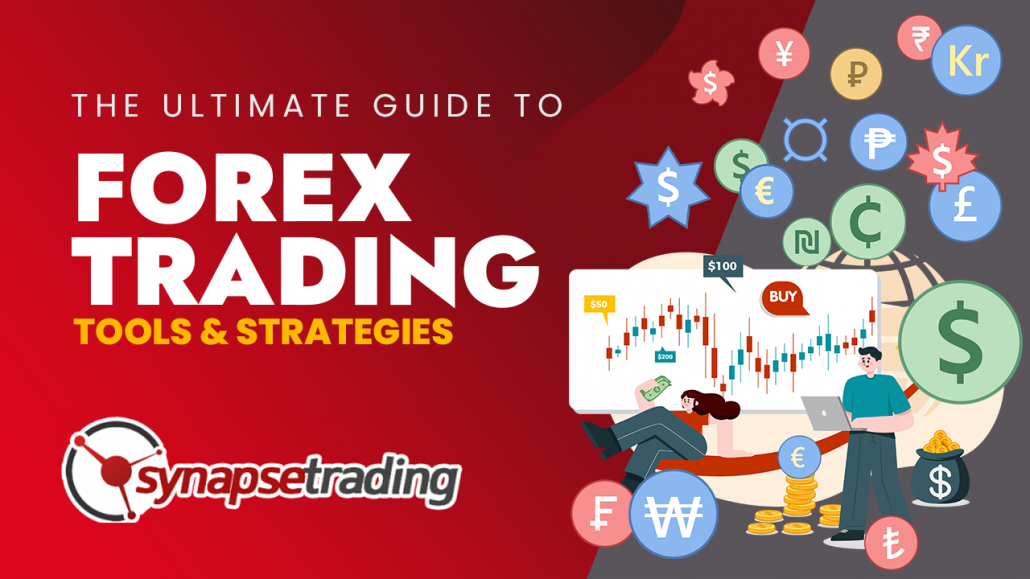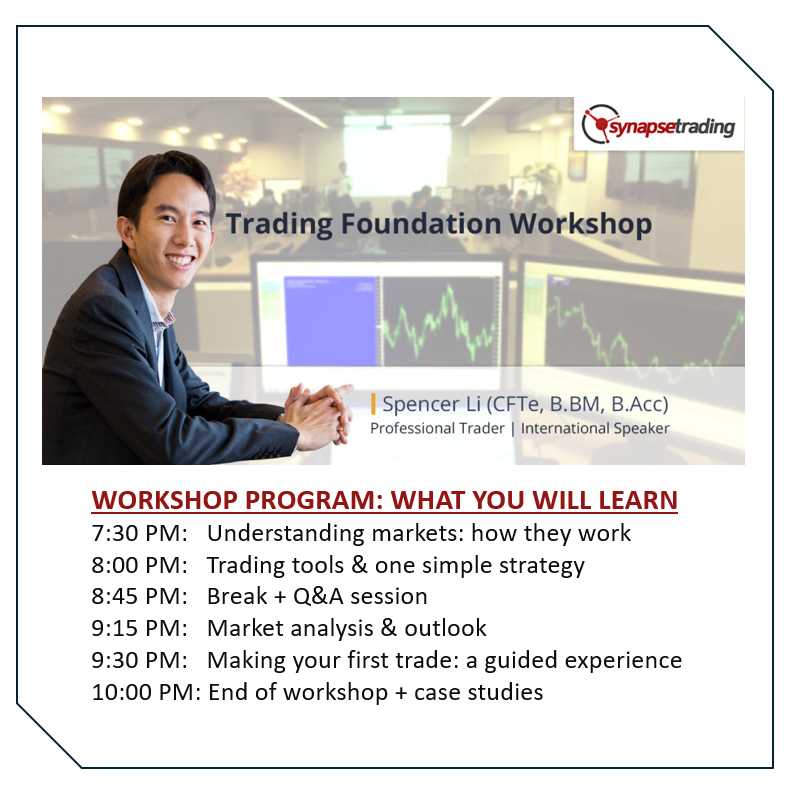The Ultimate Guide to Forex Trading
The currency markets, or foreign exchange (forex) markets are one of the biggest markets globally, where forex traders can buy or sell one currency against another, aka. forex trading or currency trading.
In this detailed guide, I have compiled everything you would need to know (even as a complete beginner), on how to start trading forex, and the best strategies, techniques and tools you can use to give you an edge in your forex trading journey.










I’ve been trading forex for a few years now, and my favourite strategy is the Price Action strategy. It’s simple and effective, and it allows me to make trading decisions based on the price movement on the chart.
I agree, Price Action is a great strategy. But my favourite is the Ichimoku Kinko Hyo strategy. It’s a trend-following strategy that uses multiple indicators to provide a comprehensive analysis of the market.
What timeframes do you use for such strategy?
I usually use D1 or H4.
I’ve never tried the Ichimoku Kinko Hyo strategy, but it sounds interesting. My favourite forex trading strategy is the Fibonacci retracement strategy. It’s a great way to identify potential support and resistance levels and make informed trading decisions.
I don’t think Fibonacci retracement strategy is useful for forex pairs though. Do you have any cases where you did well when using it?
I’ve tried the Fibonacci retracement strategy, but I find it a bit complicated. My favourite strategy is the Moving Average Crossover strategy. It’s simple, and it works well in a trending market.
I’ve used the Moving Average Crossover strategy before, and it’s a good strategy. However, I prefer the Bollinger Bands strategy. It’s a versatile strategy that can be used in both trending and ranging markets.
I am also curious what settings you did for it to work effectively?
I am surprised that such a strategy is still being applied for forex trading! How do you get it done exactly?
I’ve never tried the Bollinger Bands strategy, but I’ve heard good things about it. My favourite strategy is the Breakout strategy. It involves identifying key levels of support and resistance and waiting for a breakout to occur before making a trade.
The Breakout strategy is a good strategy, but it can be risky if the breakout is false.
Yes, when the breakout is false, you will pay for it. But with enough experience, you can identify one easily.
I use the ADX (Average Directional Index) strategy. It’s a trend-following strategy that can help me identify the strength of a trend and make informed trading decisions.
I’ve never tried the ADX strategy before, but it sounds interesting. It’s great to see so many different strategies that traders can use to be successful in the forex market. Ultimately, it comes down to finding the strategy that works best for you and your trading style.
Thank you to everyone for sharing their strategies! I’ve tried the MACD strategy, and it’s a good strategy for me.
I also usually used a combination of MACD + MA to determine entries and exits.
I like to keep my chart simple and effective to read. This works extremely well for me!
What are your hit rates for all your strategies that you have used and applied?
The most challenging part of forex trading is managing my emotions. Sometimes, I let my emotions get the best of me, and I end up making impulsive trading decisions that lead to losses.
I can relate to that. Emotions can be a significant hurdle in forex trading. For me, the most challenging part is developing a profitable trading strategy that works consistently.
Developing a profitable trading strategy is a challenge for many traders, including myself. The market is constantly changing, and it can be challenging to find a strategy that works in all market conditions.
I’ve found that the most challenging part of forex trading is managing my risk. It’s easy to get caught up in the excitement of potential profits and forget about the potential losses.
I can understand that. Risk management is critical in Forex trading. In my opinion, the most challenging part is staying disciplined and sticking to my trading plan.
Discipline is essential in Forex trading. I’ve struggled with it as well. For me, it is dealing with unexpected events that can impact the market, such as news releases or sudden price movements.
It’s important to remain calm and not let emotions drive your trading decisions when such news affects your trades. I usually take a step back and analyze how the news could impact the market in the short and long term.
That’s a great approach. I also like to keep an eye on the economic calendar and stay updated on any scheduled news releases that could affect my trades. This helps me prepare in advance and adjust my trading strategy accordingly.
Staying informed and keeping an eye on the economic calendar is definitely helpful. I also like to use a stop loss to manage my risk in case the news affects the market in an unexpected way.
Using a stop loss is essential to managing your risk in forex trading. It helps limit your potential losses in case the market moves against you due to unexpected news.
I also like to use trailing stops to maximize my profits in case the market moves in my favor after a news release. It helps me lock in profits while also minimizing my risk.
That’s a great point. Having a solid trading plan is crucial to staying disciplined and focused during volatile news events. It helps me avoid making emotional decisions that could negatively impact my trades.
Exactly. It’s important to remember that news events are a part of forex trading and can’t be avoided. However, with a clear head, proper risk management, and a solid trading plan, you can minimize your losses and take advantage of potential opportunities that arise from news events.
I know what you mean. The market can be unpredictable at times, which can make trading challenging. Finding the time to devote to trading while balancing other responsibilities is the hardest for me.
Market volatility can be challenging to navigate. I struggle with it too. For me, the most challenging part is analysing the market and identifying potential trading opportunities.
Using technical and fundamental analysis, having a solid risk management strategy, staying up to date with market news and events, and remaining patient and disciplined can all help you navigate volatile markets and identify potential trading opportunities.
Market analysis can be a complex and challenging part of forex trading. I can understand what you are going through. Staying patient and not getting discouraged when trades don’t go as planned is definitely one of my weakness.
One tip that we may have missed out on is to use a demo account to practice trading strategies before using real money. It’s a great way to test out strategies and get a feel for the market without risking real money.
Setting realistic trading goals is essential to stay motivated and focused.
How do you set the goals?
I think it’s important to set both short-term and long-term goals. Short-term goals can help you stay on track and measure progress, while long-term goals can provide direction and motivation.
Setting short-term goals also allows you to make adjustments to your trading strategies if necessary. Another important aspect of setting realistic goals is to make sure they are specific and measurable.
In addition, setting specific and measurable goals can help you track your progress and make adjustments as needed. It’s also important to set deadlines for achieving your goals to keep yourself accountable.
Setting deadlines is crucial to staying motivated and on track with your goals. It’s also important to make sure your goals are relevant to your overall trading plan and align with your risk management strategy.
Setting realistic goals based on your available resources and trading experience is important to avoid setting yourself up for failure. It’s also important to regularly review and adjust your goals as necessary to ensure they remain achievable.
Absolutely. Achieving your trading goals takes time, effort, and dedication. It’s important to enjoy the journey and celebrate your successes along the way while also learning from your mistakes and continuously improving your trading strategies.
That’s a great tip. Another one could be to keep a trading journal to track your progress and identify areas where you can improve your trading strategies.
Staying informed about global events is crucial for forex traders. It can provide valuable insights into market trends and potential trading opportunities. Another way could be to diversify your trading portfolio and not put all your eggs in one basket.
I agree, there are many global events happening at any given time. In my opinion, we should pay close attention to economic data releases, such as employment reports, central bank meetings, and inflation reports, as they can have a significant impact on the forex market.
Economic data releases are important to follow. But we should also keep an eye on political events, such as elections or geopolitical tensions, as they can also cause market volatility.
Political events can have a significant impact on the forex market, especially if they lead to changes in government policies or global trade agreements.
Natural disasters and climate-related events, such as hurricanes or droughts, can affect commodity prices and impact the forex market. I feel that most people usually overlook this.
That’s a great point. Natural disasters and climate-related events can have a ripple effect on the global economy and should not be overlooked. But how do we stay informed about all of these events?
I rely on a combination of news outlets, social media, and economic calendars. I also subscribe to newsletters and follow influential traders and analysts on social media to get their insights.
That’s an interesting point. Analyzing market sentiment can give us valuable insights into how other traders are reacting to global events and how they are positioning their trades.
I also find it helpful to analyze market sentiment and see how other traders are reacting to these events.
Diversification is a great tip. It can help reduce risk and increase the potential for profits. Another tip could be to set realistic trading goals and have a plan in place to achieve them.
Technical analysis tools are valuable for forex traders. They can provide valuable insights into market trends and potential entry and exit points.
Keeping up with forex news and updates is crucial for forex traders. It can provide valuable insights into market trends and potential trading opportunities. Another tip could be to learn from your mistakes and use them as an opportunity to improve your trading strategies.
After reading through the guide, I found the explanations on forex lot size and leverage in forex very helpful. It provided me with a better understanding of how much money I am trading and how much risk I am taking.
I think the guide did a great job of introducing the different types of currency pairs, including major currency pairs, cross currency pairs, and exotic currencies. It helped me understand which currency pairs are more popular and which ones are riskier to trade.
The guide did an excellent job of explaining the basics of forex trading, especially for beginners. I also found the explanation of base and quote currency and how they work together helpful.
For me, I found the explanation on pips interesting. It gave me a better understanding of how to calculate my potential profits and losses for each trade.
I forgot to mention that the guide also explained the characteristics of each currency pair, such as their volatility and liquidity. This information will be helpful in identifying trading opportunities.
One thing that stood out to me is the importance of understanding currency pair correlations. It’s crucial to consider how one currency pair’s movement may affect another, especially when trading multiple currency pairs.
Correlations between currency pairs can be positive or negative, and it’s important to understand how they work. The guide did a good job of explaining this concept.
I think the guide provided a great overview of forex trading terminologies. However, it’s important to remember that forex trading involves risks, and it’s essential to have a solid trading plan and risk management strategy.
It’s easy to get caught up in the excitement of trading, but it’s crucial to remain disciplined and stick to your trading plan. The guide provided a good foundation, but continuous learning and practice are also necessary for success in forex trading.
I found this guide on forex trading for beginners to be very informative, especially the introduction section that explained the basics of the forex market and how it differs from other markets like stocks and crypto. My key takeaway from this section is that the forex market is the largest and most liquid market in the world, and it operates 24 hours a day, five days a week.
I agree with you, the introduction section was really helpful. Another important point that I learned from this guide is the significance of the best trading hours in forex trading. According to the guide, the top three forex trading hours are during the overlap of the London and New York sessions, the Tokyo and London sessions, and the Sydney and Tokyo sessions. My key takeaway from this section is that these hours are when the most volume and volatility occur in the forex market.
The section on the difference between stocks and forex was quite interesting. I always thought that they were similar, but this guide made it clear that forex trading involves buying and selling currency pairs, while stock trading is buying and selling shares of companies. My key takeaway from this section is that the forex market is much larger than the stock market, and it has a higher level of liquidity.
I also found the section on the difference between crypto and forex to be informative. The guide explained that while both markets involve buying and selling assets, crypto trading is much more volatile and unpredictable than forex trading. My key takeaway from this section is that forex trading is generally considered to be less risky than crypto trading, and it is a better option for beginners.
Another important point that I learned from this guide is the concept of forex lot size. The guide explains that forex lot size refers to the amount of currency being traded in a single transaction, and it can vary from micro lots to standard lots. My key takeaway from this section is that forex traders need to understand lot size and its impact on their trading strategy.
The section on leverage in forex was also quite helpful. The guide explained that leverage allows traders to control larger positions in the market with a smaller amount of capital. My key takeaway from this section is that while leverage can increase profits, it can also magnify losses, so it is important to use it wisely and with caution.
I found the section on pips to be quite interesting. The guide explained that a pip is the smallest unit of measurement in forex trading, and it refers to the fourth decimal place in currency pairs. My key takeaway from this section is that understanding pips is essential for calculating profits and losses in forex trading.
The section on base and quote currency was also informative. The guide explains that the base currency is the currency on the left of the currency pair, and the quote currency is the currency on the right. My key takeaway from this section is that understanding base and quote currency is essential for forex traders, as it helps them to determine the value of a currency pair.
The section on major currency pairs, cross currency pairs, and exotic currencies was quite helpful in understanding the different types of currency pairs that are traded in the forex market. My key takeaway from this section is that major currency pairs have high liquidity and are the most commonly traded, while exotic currencies have low liquidity and are not traded as frequently.
The section on currency pair correlations and characteristics was quite interesting. The guide explains that currency pairs can have a positive or negative correlation with each other, and understanding these correlations can help traders to diversify their portfolio and minimize risk. My key takeaway from this section is that currency pair correlations can have a significant impact on trading strategies
My key takeaway from this guide is that it is crucial to understand the basics of forex trading before diving into it. Knowing the difference between forex, stocks, and crypto markets is essential to make informed decisions. Additionally, understanding the best trading hours is vital to increase profitability and minimize risks. Overall, this guide has provided a great starting point for beginners to enter the forex market.
I agree with you. As a beginner, it can be overwhelming to enter the forex market without proper knowledge. Understanding the fundamentals and the differences between various markets is essential to create a successful trading strategy. Moreover, focusing on the best trading hours can increase the likelihood of profitable trades. This guide has provided a great starting point for me, and I’m excited to learn more about forex trading.
You are right about the importance of understanding the basics before trading in the forex market. I think it’s equally essential to have realistic expectations and avoid overtrading. Forex trading is not a get-rich-quick scheme, and it takes time and patience to see results. Moreover, trading too frequently can lead to poor decision-making and burnout. Therefore, it’s crucial to have a balanced approach and focus on quality trades.
It’s easy to get caught up in the excitement of forex trading and forget about the importance of risk management. As traders, we need to set realistic expectations, use stop-loss orders, and diversify our portfolio to minimize risks. Additionally, having a trading plan and sticking to it can help us avoid emotional trading decisions and improve our chances of success.
Overall, this guide has provided valuable insights into the world of forex trading for beginners. From understanding the basics and differences between markets to focusing on the best trading hours and risk management, there is a lot to consider. My key takeaway from this guide is that forex trading can be profitable, but it requires time, patience, and a well-thought-out strategy. Thank you for the valuable information, and I’m excited to start my forex trading journey.
It would be helpful to include more real-life examples and case studies to further illustrate the concepts discussed in each thread. This could help beginners better understand how to apply the information in real-world trading situations.
Wow, this guide is really comprehensive! My key take-away from this section is that there are different strategies and patterns that you can use depending on your trading style preference. I’m definitely going to look into the best trading indicators to use in my own Forex trading.
I totally agree! For me, the best part of this section was learning about the different forex trading strategies, including their pros and cons. It’s great to have so many options to choose from, and I think it’s important to find a strategy that works best for your own personality and trading style.
I was interested to learn about the different types of forex trading strategies. I had no idea that there were so many options, including scalping, day trading, swing trading, and position trading. It’s good to know that there’s a strategy out there for every type of trader.
For me, the best take-away from this guide was the section on the best trading hours for forex trading. I had no idea that there were specific hours during the day when the market is most active and volatile. This information will definitely help me plan my trading schedule better.
I found the section on Forex trading indicators to be really helpful. It’s important to have a variety of indicators to use in your trading, and this section provided a great overview of the most popular ones. I’m definitely going to experiment with using different indicators to see which ones work best for me.
Overall, my key take-away from this guide is that forex trading is a complex and multifaceted market. There are so many different strategies, patterns, and indicators to learn and use, and it’s important to find what works best for you. However, with the right tools and knowledge, anyone can become a successful forex trader.
The Best Forex Trading Strategy for Beginners section caught my attention, as it provides a comprehensive guide for those who are new to trading. The Best Forex Price Chart Patterns and Best Forex Candlestick Patterns sections are also helpful for those who rely on technical analysis.
The Strategies for Forex & Currency Trading section is quite informative, and it provides a comprehensive guide on various trading strategies. The Best Forex Trading Entries to Take a Trade Position section is particularly helpful as it outlines the factors to consider before taking a trade.
This trading guide is quite useful, and it provides a comprehensive overview of the forex market, including the best trading hours to focus on. The When is the Best Time to Trade Forex? section is quite insightful, especially for those who are new to trading.
This trading guide is quite comprehensive, and it covers different aspects of the forex market, including the Best Forex Price Action Patterns and Best Forex Trading Indicators. I found these sections quite informative.
One thing I found interesting was the section on candlestick patterns. I had no idea that there were so many different patterns, and that each one could indicate a different market trend. I’m definitely going to study up on these patterns and try to incorporate them into my own Forex trading.
I found the section on price chart patterns to be particularly helpful. It’s important to be able to recognize these patterns in order to identify potential trading opportunities. I also learned that there are different types of chart patterns, including reversal and continuation patterns.
As a beginner, I appreciated the section on the best forex trading strategy for beginners. It’s important to start with a solid foundation, and this section provided a great starting point. I also liked the section on the best forex trading entries – this will definitely help me with timing my trades better.
I enjoy seeing this discussion approach is an effective way to encourage discussion and collaboration among traders of all skill levels, which can lead to new insights and strategies for trading in the Forex market.
The information provided is well-organized and easy to understand, which is crucial for beginners who may be overwhelmed by the complexity of the Forex market.
This trading guide was very informative and helpful for someone like me who is just starting out in forex trading. I appreciate the diversity of topics covered and the clear explanations provided.
As a forex trader, my favourite currency market analysis tool is the Economic Calendar. It helps me stay up-to-date with all the latest news and events that could potentially impact the currency markets.
I agree, the Economic Calendar is a great tool. But I prefer using the Moving Average indicator. It’s a simple and effective tool that can help me identify trends and potential trading opportunities.
I completely agree. A trading journal is an excellent way to hold yourself accountable and stay on track with your trading goals. Another tip could be to stay informed about global events that can impact the currency markets.